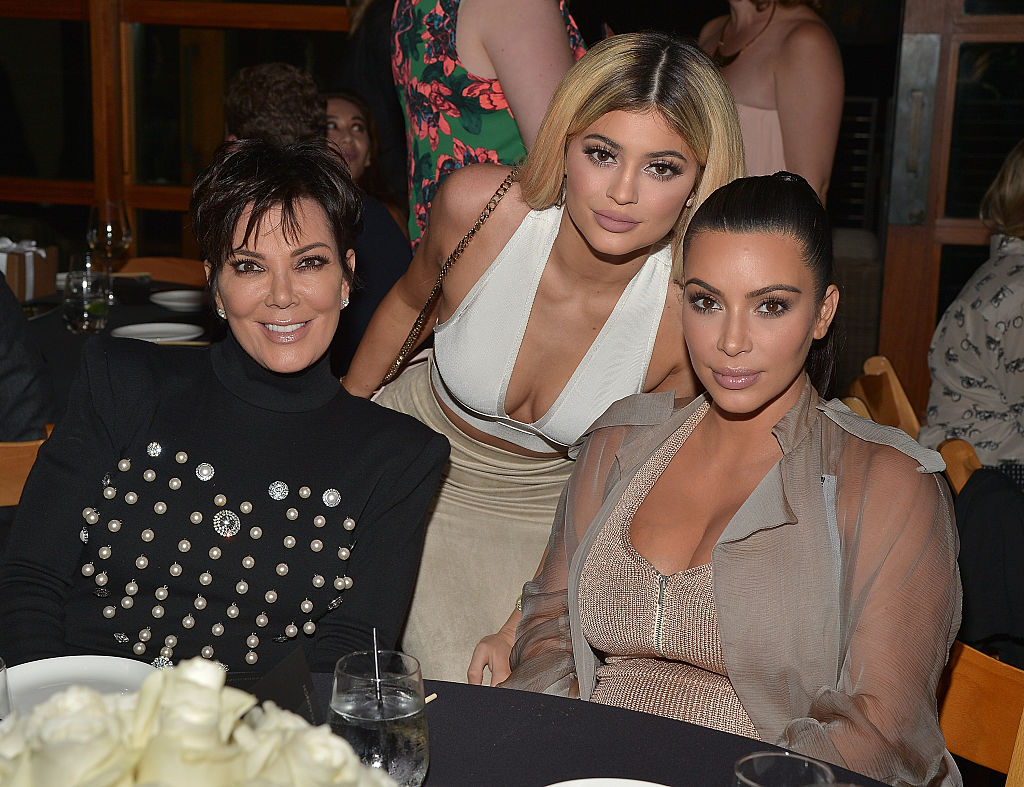Kylie Jenner’s Clothing Brand Is Stiffing Workers. It’s Time to Organize the Stans.
Kylie Jenner’s clothing line is stiffing garment workers in Bangladesh, who have long lacked the bargaining power to improve their conditions. But the industry is changing — and consumer action linked to workplace militancy could actually win gains for these workers.

Kim Kardashian West, Kylie Jenner, and Kris Jenner host a dinner in Malibu, California. (Photo by Charley Gallay / Getty Images for Kardashian / Jenner Apps)
Kylie Jenner, already infamous for selling diet tea that causes explosive diarrhea, is now embroiled in a different kind of scandal: stiffing garment workers on pay. Global Brand Group, the entity that runs several Kardashian-Jenner family brands, has come under fire for dissolving its Bangladesh-based operations (citing COVID-era uncertainty), leaving thousands of workers “starving” and angry.
Fashion Nova, which runs rapper Cardi B’s line, has given similar reasons for pulling contracts in Los Angeles and throwing upwards of fifty thousand workers off payroll, most of them immigrant women who do not qualify for unemployment benefits. Such cut-and-run maneuvers are all too common in the garment industry, especially in Bangladesh.
Bangladesh is an industrial one-trick pony. Eighty-four percent of its export revenue comes from ready-made garments that workers (mostly women) churn out for primarily Western markets. However, since the COVID-19 pandemic, global demand has plummeted, brands and retailers have bailed on suppliers, and factories have shut down, laying off a million garment workers — a quarter of the country’s garment labor force.
Power within the garment sector has always turned on a twin axis: first, the power imbalance between workers and factory owners; second, the power imbalance between factory owners in poor countries like Bangladesh, and large brands and retailers based in wealthy countries like the UK. Both have shaped garment workers’ ability to advocate for their interests and secure a decent existence.
Sweatshop conditions have persisted because large oligopolistic buyers (brands and retailers) have enjoyed the upper hand against a sea of suppliers (factory owners). (Scholars describe this as a situation of monopsony — many suppliers and few buyers.) Unable to muster the capital necessary to escape the orbit of brand power, local manufacturers have violently opposed any demands from workers, knowing it would cut into their already modest margins.
Workers have been left with poverty wages, deteriorating workplace standards, and increasing incidences of factory fire and collapse. In 2013, the Rana Plaza in Dhaka, Bangladesh collapsed, killing 1,129 workers and injuring many more. It was the deadliest structural failure in modern history.
But recent years have brought disruptive new dynamics, some with the ability to give workers a better structural bargaining position. The most important is consolidation among suppliers. As brands and retailers became more concentrated, boosting their monopoly power, the price they were willing to pay for a shirt or a shoe fell. Fewer and fewer suppliers were able to compete for the price demands of increasingly oligopolistic brands and retailers. The result: small and medium size suppliers were bought out by larger suppliers.
Large retailer brand oligopolies (like Global Brand Group, the company that runs the Kardashian-Jenner family brands) have come to benefit from growing profits produced by economies of scale and integration, while becoming dependent on increasingly oligopolistic outsourced manufacturers. What has emerged is a calcified relationship that locks in global buyers with global suppliers.
Before this latest stage set in, garment workers had been launching campaigns organized around a rights-based framework (codes, audits, and so on), but lacked the footing to fight a globalized, vertically disintegrated industry. But now, centralization and inflexibility in the supply chain have rendered the relevant workforces much more important, substantially increasing their relative structural power. They are no longer so disposable.
The COVID-19 crisis should deepen these dynamics, spurring a new wave of consolidation as weaker suppliers fail and larger capital-holding firms take them over. The shakeout is likely to eliminate much of the excess productive capacity in the industry, further empowering the remaining suppliers against the brands and retailers.
These changes open up new possibilities for workers. And they know it. Workers are asserting their disruptive power against their increasingly consolidated employers, taking advantage of the shifting terrain. We could even be seeing the twilight of the sweatshop age.
But change will require the secondary support of consumers in the Global North. Social media is already boiling over with criticism, as users condemn the hypocrisy of celebrities like Kylie Jenner, who claim solidarity with Black Lives Matter and other social justice movements, while stealing — quite literally — from the legions of brown women who make the products bearing their names.
And because fame is fickle, this is a surprisingly effective tactic. Being subject to the vagaries of fandom, where “likes” elect instant millionaires and throw has-beens on the street, exposes them to all types of public pressure. If Western consumers play their cards right, gathering numbers while loudly pleading their case in moral terms, they can usually wear down and eventually compel celebrities to do the right thing.
None of this is a substitute for workplace militancy, but consumer action can complement worker struggles on the factory floor. In other words, it is time to organize the stans.